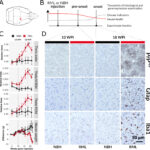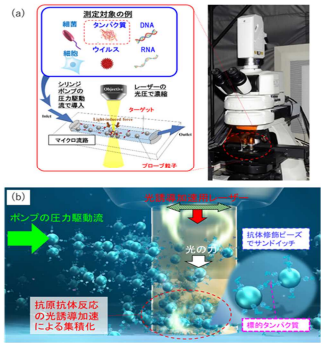研究者らは、マウスの脳内で、数百の神経細胞の単一ニューロン活動と局所的なネットワーク活動をモニターした Researchers monitored single-neuron activity from hundreds of neurons along with the local network activity in the brains of mice
2022-10-10 カリフォルニア大学サンディエゴ校(UCSD)
この研究では、マウスの脳の2次元平面上で数百のニューロンの電気記録と光学イメージングを同時に可能にする新技術「E-Cannula」を紹介する。これは、脳波、リズム、振動などの集団レベルの神経細胞のダイナミクスを、同じ脳領域の大規模な神経細胞集団の単一ニューロン活動とともに研究できる、待望の神経科学のブレークスルーとなるものである。
この技術を用いて、研究者らは、学習やナビゲーションに重要な脳の領域である海馬において、特定の高周波リズムや鋭い波の波紋が、異なる細胞集合体を選択的に勧誘することを明らかにした。
E-Cannulaは、柔軟な透明微小電極と、脳に埋め込むイメージングカニューレを一体化しています。透明で柔軟な微小電極には、透明で低ノイズ、かつ非常に柔軟なグラフェンの単層膜が使用されています。神経信号をモニターするために使用されるグラフェン電極とワイヤは、微細加工技術を使ってパターン化される。透明で柔軟なポリマーの2層がグラフェンワイヤーを包み込み、デバイスを電気的に絶縁するとともに、長期の生体内実験に耐える保護機能を提供する。透明電極の柔軟性により、電極は最大90度まで曲がり、イメージングカニューレの急峻な側壁に適合することができる。透明電極は、120回の曲げ加工により機械的ストレスを与えた後でも、安定した電気記録能力を示した。
<関連情報>
- https://today.ucsd.edu/story/new-technology-from-uc-san-diego-cracks-fundamental-challenge-in-neuroscience
- https://www.cell.com/cell-reports/fulltext/S2211-1247(22)01294-3
E-Cannulaは、海馬の異なるアセンブリの採用のためのドライバーとして、鋭い波の波紋の解剖学的多様性を明らかにした E-Cannula reveals anatomical diversity in sharp-wave ripples as a driver for the recruitment of distinct hippocampal assemblies
Xin Liu,Satoshi Terada,Mehrdad Ramezani ,Jeong-Hoon Kim,Yichen Lu,Andres Grosmark,Attila Losonczy,Duygu Kuzum
Cell Reports OCTOBER 04, 2022
DOI:https://doi.org/10.1016/j.celrep.2022.111453

Highlights
•Two-photon imaging and electrophysiological recording from the same hemisphere of CA1
•Multiunit spiking activity phase locked to local ripples
•Local ripple generation and propagation along the septotemporal and transverse axes
•Distinct spatiotemporal ripple patterns recruiting orthogonal cell assemblies
Summary
The hippocampus plays a critical role in spatial navigation and episodic memory. However, research on in vivo hippocampal activity dynamics mostly relies on single modalities, such as electrical recordings or optical imaging, with respectively limited spatial and temporal resolution. Here, we develop the E-Cannula, integrating fully transparent graphene microelectrodes with imaging cannula, which enables simultaneous electrical recording and two-photon calcium imaging from the exact same neural populations across an anatomically extended region of the mouse hippocampal CA1 stably across several days. The large-scale multimodal recordings show that sharp wave ripples (SWRs) exhibit spatiotemporal wave patterns along multiple axes in two-dimensional (2D) space with different spatial extents and temporal propagation modes. Notably, distinct SWR wave patterns are associated with the selective recruitment of orthogonal CA1 cell assemblies. These results demonstrate the utility of the E-Cannula as a versatile neurotechnology with the potential for future integration with other optical components.


